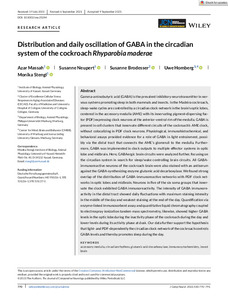| dc.date.accessioned | 2022-02-14T16:33:32Z | |
| dc.date.available | 2022-02-14T16:33:32Z | |
| dc.date.issued | 2021-09-29 | |
| dc.identifier | doi:10.17170/kobra-202202015682 | |
| dc.identifier.uri | http://hdl.handle.net/123456789/13614 | |
| dc.description.sponsorship | Gefördert im Rahmen des Projekts DEAL | ger |
| dc.description.sponsorship | Deutsche Forschungsgemeinschaft. Grant Numbers: HO 950/26-1, STE 531/26-1, STE 531/27-1 | |
| dc.language.iso | eng | eng |
| dc.rights | Namensnennung-Nicht-kommerziell 4.0 International | * |
| dc.rights.uri | http://creativecommons.org/licenses/by-nc/4.0/ | * |
| dc.subject | accessory medulla | eng |
| dc.subject | circadian rhythms | eng |
| dc.subject | glutamic acid decarboxylase | eng |
| dc.subject | immunocytochemistry | eng |
| dc.subject | insect brain | eng |
| dc.subject.ddc | 570 | |
| dc.title | Distribution and daily oscillation of GABA in the circadian system of the cockroach Rhyparobia maderae | eng |
| dc.type | Aufsatz | |
| dcterms.abstract | Gamma-aminobutyric acid (GABA) is the prevalent inhibitory neurotransmitter in nervous systems promoting sleep in both mammals and insects. In the Madeira cockroach, sleep-wake cycles are controlled by a circadian clock network in the brain's optic lobes, centered in the accessory medulla (AME) with its innervating pigment-dispersing factor (PDF) expressing clock neurons at the anterior-ventral rim of the medulla. GABA is present in cell clusters that innervate different circuits of the cockroach's AME clock, without colocalizing in PDF clock neurons. Physiological, immunohistochemical, and behavioral assays provided evidence for a role of GABA in light entrainment, possibly via the distal tract that connects the AME's glomeruli to the medulla. Furthermore, GABA was implemented in clock outputs to multiple effector systems in optic lobe and midbrain. Here, GABAergic brain circuits were analyzed further, focusing on the circadian system in search for sleep/wake controlling brain circuits. All GABA-immunoreactive neurons of the cockroach brain were also stained with an antiserum against the GABA-synthesizing enzyme glutamic acid decarboxylase. We found strong overlap of the distribution of GABA-immunoreactive networks with PDF clock networks in optic lobes and midbrain. Neurons in five of the six soma groups that innervate the clock exhibited GABA immunoreactivity. The intensity of GABA immunoreactivity in the distal tract showed daily fluctuations with maximum staining intensity in the middle of the day and weakest staining at the end of the day. Quantification via enzyme-linked immunosorbent assay and quantitative liquid chromatography coupled to electrospray ionization tandem mass spectrometry, likewise, showed higher GABA levels in the optic lobe during the inactivity phase of the cockroach during the day and lower levels during its activity phase at dusk. Our data further support the hypothesis that light- and PDF-dependently the circadian clock network of the cockroach controls GABA levels and thereby promotes sleep during the day. | eng |
| dcterms.accessRights | open access | |
| dcterms.creator | Massah, Azar | |
| dcterms.creator | Neupert, Susanne | |
| dcterms.creator | Brodesser, Susanne | |
| dcterms.creator | Homberg, Uwe | |
| dcterms.creator | Stengl, Monika | |
| dc.relation.doi | doi:10.1002/cne.25244 | |
| dc.relation.projectid | Grant Numbers: HO 950/26-1, STE 531/26-1, STE 531/27-1 | |
| dc.subject.swd | Küchenschabe | ger |
| dc.subject.swd | Tagesrhythmus | ger |
| dc.subject.swd | Knochenmark | ger |
| dc.subject.swd | Aminobuttersäure <gamma-> | ger |
| dc.subject.swd | Glutamat-Decarboxylase | ger |
| dc.subject.swd | Immuncytochemie | ger |
| dc.subject.swd | Insekten | ger |
| dc.subject.swd | Gehirn | ger |
| dc.type.version | publishedVersion | |
| dcterms.source.identifier | eissn:1096-9861 | |
| dcterms.source.issue | Issue 5 | |
| dcterms.source.journal | JCN (The journal of comparative neurology) | eng |
| dcterms.source.pageinfo | 770-791 | |
| dcterms.source.volume | Volume 530 | |
| kup.iskup | false | |


